外国学校教师授课讲义模板opensourcelibrar
英文老师课件教案模板范文
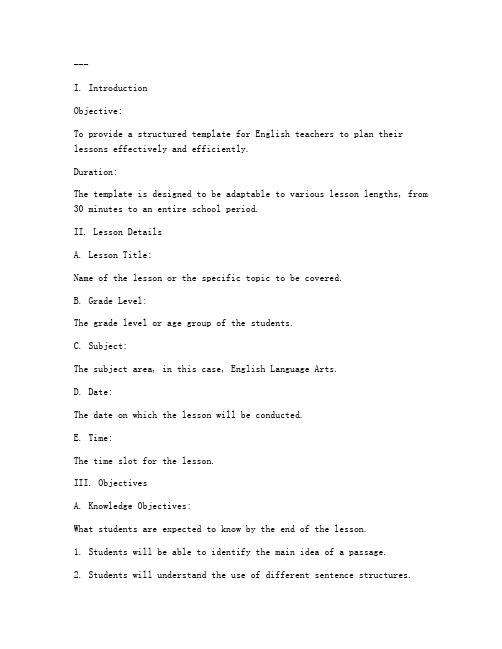
---I. IntroductionObjective:To provide a structured template for English teachers to plan their lessons effectively and efficiently.Duration:The template is designed to be adaptable to various lesson lengths, from 30 minutes to an entire school period.II. Lesson DetailsA. Lesson Title:Name of the lesson or the specific topic to be covered.B. Grade Level:The grade level or age group of the students.C. Subject:The subject area, in this case, English Language Arts.D. Date:The date on which the lesson will be conducted.E. Time:The time slot for the lesson.III. ObjectivesA. Knowledge Objectives:What students are expected to know by the end of the lesson.1. Students will be able to identify the main idea of a passage.2. Students will understand the use of different sentence structures.B. Skills Objectives:What students are expected to be able to do by the end of the lesson.1. Students will be able to construct simple sentences using past tense verbs.2. Students will practice listening skills through a group activity.C. Attitude Objectives:What attitudes or dispositions students are expected to develop.1. Students will develop a positive attitude towards reading.2. Students will be encouraged to participate actively in class discussions.IV. MaterialsA. Textbooks and Handouts:List any textbooks, workbooks, or handouts that will be used.1. Textbook: "English Grammar in Use"2. Handout: "Past Tense Practice Sheet"B. Technology:Any technology that will be used during the lesson.1. Interactive whiteboard2. Computers for a group activityC. Other Materials:Any other materials needed for the lesson.1. Markers and paper for student writing2. Flashcards for vocabulary practiceV. ProceduresA. Introduction (5 minutes):1. Briefly review the previous lesson's content.2. Introduce the new topic with an engaging activity or question.B. Instruction (20-30 minutes):1. Present new vocabulary and grammar points.2. Demonstrate how to use the target language with examples.3. Provide guided practice exercises.C. Practice (15-20 minutes):1. Have students work in pairs or small groups to practice the new language.2. Circulate and provide individual assistance as needed.D. Application (10-15 minutes):1. Conduct a whole-class activity that applies the new language.2. Use real-life scenarios or role-plays to reinforce learning.E. Closure (5 minutes):1. Summarize the key points of the lesson.2. Assign homework or review the next lesson's objectives.VI. AssessmentA. Formative Assessment:Methods for assessing student understanding and progress during the lesson.1. Observations of student participation and engagement.2. Exit tickets to gauge understanding of the day's content.B. Summative Assessment:Methods for assessing student learning at the end of the lesson or unit.1. Quizzes or tests on vocabulary and grammar.2. Projects or presentations that demonstrate understanding of the material.VII. ReflectionA. Teacher Reflection:What the teacher will consider after the lesson to improve future teaching.1. How well the students engaged with the material.2. Which activities were most effective and which could be improved.B. Student Feedback:How the teacher will gather and use student feedback to improve the lesson.1. Conduct a quick exit poll to gather student opinions on the lesson.2. Encourage students to provide specific suggestions for future lessons.---This template is designed to be flexible, allowing teachers to adjust the content and structure based on their specific needs and the needs of their students.。
外语教学课件英文版

外语教课课件英文版外语教课课件英文版已经为大家准备好啦,老师们,大家能够参照以下教课设计内容,整理好自己的讲课思路哦!eaching Objectives:Grasp the Past Continuous Tense.Language focus:cook a meal, play volleyball, PE/physicaleducation, chemistry lab, feed, sweep the floor, look outof...Properties: Tape-recorder, Overhead projector,课本挂图。
Teaching procedures:Step 1 Revision1. Act out the play about neighbourhood relationship. Other students answer the question “ What were they doing in the play?”.2. Revise the Past Continuous Tense by performing actions, such as: cleaning the floor, closing the window.What was I doing? What was he/she doing? Whatwere they doing?Step 2 PresentationDraw this time table on the blackboard. (or on a flashcard) as a model:Yesterday: Li Lei9:0010:20noonreading playing football12:001:404:40having a rest shopping with JimPresent this dialogue:A: What was Li Lei doing at half past nine yesterday morning?B: He was reading.Get the students to practise the dialogue with other time. Repeat it for Han Mei instead of Li Lei.Get the students to ask and answer in pairs.Step 3 Ask and answerStudents ask and answer the questions in pairs.Then get the students to draw a time line showing what they were doing at a certain period of time last Sunday. Have them ask and answer about what they were really doing.Explain the word: PE, chemistry,sweep Step 4 PracticeShow the students the picture and say: One Sunday morning the man upstairs heard the sound of children playing in the park. What did he see when he looked out of his window.Now look at the picture, what were the childrenand other people doing?Explain the using of playing in the park.Get the students to ask and answer in pairs.A:What was the man doing?B:He was selling the fruit.The boys were playing basketball.Do WB EX.1.Play the video: 过去进行时 , Get the students toact in pair.Step 5 ExerciseAsk questions.1.The girlwas making a paper boat.2.Tonywas telling a story.3.My brother was playing the pianoat six o clock yesterday.4.They were doing homework. (general question)Keys: 1. What was the girl doing?2.Who was telling a story?3.When was your brother playing the piano?4.Were they doing homework?Step 6 Homework1.Write a short article to describe the picture in this lesson.2.Draw a picture for other students to talk about.3.Do exercises on page 117. Finish off the workbook exercises.Writing on blackboard。
全英文讲课模板
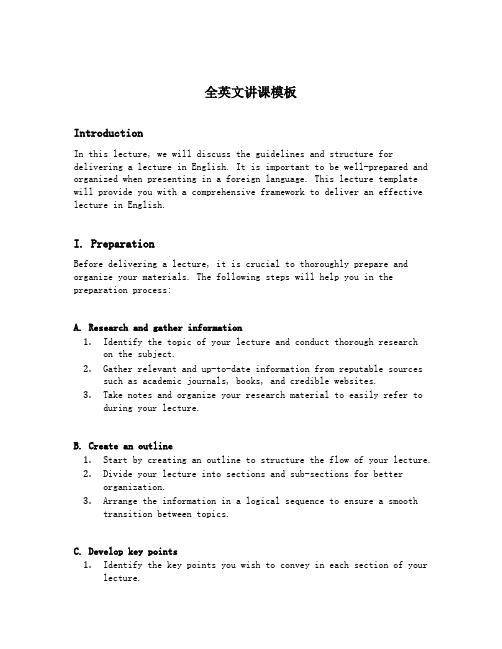
全英文讲课模板IntroductionIn this lecture, we will discuss the guidelines and structure for delivering a lecture in English. It is important to be well-prepared and organized when presenting in a foreign language. This lecture template will provide you with a comprehensive framework to deliver an effective lecture in English.I. PreparationBefore delivering a lecture, it is crucial to thoroughly prepare and organize your materials. The following steps will help you in the preparation process:A. Research and gather information1.Identify the topic of your lecture and conduct thorough researchon the subject.2.Gather relevant and up-to-date information from reputable sourcessuch as academic journals, books, and credible websites.3.Take notes and organize your research material to easily refer toduring your lecture.B. Create an outline1.Start by creating an outline to structure the flow of your lecture.2.Divide your lecture into sections and sub-sections for betterorganization.3.Arrange the information in a logical sequence to ensure a smoothtransition between topics.C. Develop key points1.Identify the key points you wish to convey in each section of yourlecture.e bullet points or concise sentences to summarize the main ideas.3.Prioritize the key points based on their importance and relevanceto the topic.D. Prepare visual aids (if necessary)1.Determine if visual aids, such as PowerPoint slides, will enhanceyour lecture.2.Create visually appealing and informative slides to support yourkey points.3.Ensure that the visual aids are clear and easy to understand.II. Structure of the LectureA well-structured lecture will help the audience follow and understand your presentation. The structure of the lecture should include the following elements:A. Introduction1.Begin by introducing yourself and providing a brief backgroundrelated to the topic.2.State the objectives of your lecture and what the audience canexpect to learn.3.Capture the attention of the audience with a compelling openingstatement or anecdote.B. Main Body1.Present the main ideas and key points of your lecture.e clear and concise language to effectively convey your message.3.Support your key points with evidence, examples, or relevant data.e visual aids to enhance the audience’s understanding, i fapplicable.5.Transition smoothly between topics to maintain the flow of thelecture.C. Conclusion1.Summarize the main points covered in the lecture.2.Emphasize the key takeaways and why they are important.3.Provide a sense of closure to the lecture by reinforcing the mainideas.4.Encourage audience engagement by allowing time for questions anddiscussion.III. Delivery TipsDelivering a lecture in English can be challenging, especially if it is not your first language. The following tips will help you improve your delivery:A. Practice and rehearse1.Practice your lecture multiple times to become familiar with thecontent.2.Rehearse in front of a mirror or record yourself to evaluate yourspeaking style.3.Pay attention to your pronunciation, intonation, and pace.B. Use appropriate languagee clear and simple language to ensure understanding.2.Avoid complex vocabulary and jargon that may confuse the audience.3.Define any technical terms that are essential to the lecture.C. Maintain eye contact1.Engage with the audience by maintaining eye contact.2.Look at different sections of the audience to connect withindividuals.e gestures and body language to enhance your communication.D. Manage time effectively1.Keep track of time and ensure that you cover all the key points.2.Practice pacing yourself to avoid rushing or speaking too slowly.3.Allocate time for questions and discussion at the end of thelecture.ConclusionBy following this lecture template, you can deliver a well-structured and effective lecture in English. Remember to thoroughly prepare, organize your materials, and practice your delivery. Delivering a lecture in a foreign language can be challenging, but with proper preparation and delivery techniques, you can effectively engage and educate your audience.。
教师讲义教学模板

请在此输入你的标题
3
LOREM IPSUM DOLOR SIT AMET CONSECTETUER
极简主义设计,极致简约风潮流所向,通用设计,完善兼容,打造最实用,最具个性的演示方案,让你的演示杰出特殊。极简主义设计,极致简约风潮流所向,通用设计,完善兼容,打造最实用,最具个性的演示方案,让你的演示杰出特殊。极简主义设计,极致简约风潮流所向,通用设计,完善兼容,打造最实用,最具个性的演示方案,让你的演示杰出特殊。
1
LOREM IPSUM DOLOR SIT AMET CONSECTETUER
极简主义设计,极致简约风潮流所向,通用设计。
点击添加标题
点击添加标题
点击添加标题
点击添加标题
极简主义设计,极致简约风潮流所向,通用设计。
极简主义设计,极致简约风潮流所向,通用设计。
极简主义设计,极致简约风潮流所向,通用设计。
标题
标题
标题
标题
标题
请在此输入你的标题
4
LOREM IPSUM DOLOR SIT AMET CONSECTETUER
极简主义设计,极致简约风潮流所向,通用设计,完善兼容,打造最实用,最具个性的演示方案,让你的演示杰出特殊。极简主义设计,极致简约风潮流所向,通用设计,完善兼容,打造最实用,最具个性的演示方案,让你的演示杰出特殊。
极简主义设计,极致简约风潮流所向,通用设计,完善兼容,打造最实用,最具个性的演示方案,让你的演示杰出特殊。
极简主义设计,极致简约风潮流所向,通用设计,完善兼容,打造最实用,最具个性的演示方案,让你的演示杰出特殊。
极简主义设计,极致简约风潮流所向,通用设计,完善兼容,打造最实用,最具个性的演示方案,让你的演示杰出特殊。
教师公开课展示英文模板
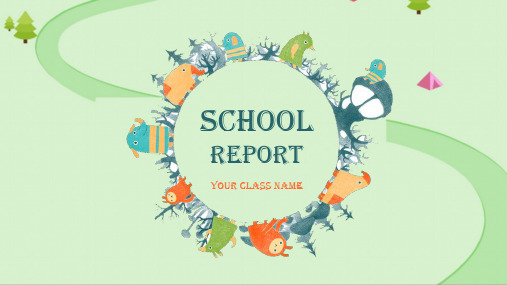
TITLE ADD HERE
TITLE ADD HERE
Lorem ipsum doloror amet consectetur adipisicing elit sed do eiusmod tempor
TITLE ADD HERE
Lorem ipsum doloror amet consectetur adipisicing elit sed do eiusmod tempor
01
adipisicing elit sed do eiusmod tempor
02
TITLE ADD HERE
Lorem ipsum doloror amet consectetur
adipisicing elit sed do eiusmod tempor
04
TITLE ADD HERE
Lorem ipsum doloror amet consectetur adipisicing elit sed do eiusmod tempor
TITLE ADD HERE
Lorem ipsum doloror amet consectetur adipisicing elit sed do eiusmod tempor
School Report
TITLE Add Here
Lorem ipsum doloror amet consectetur adipisicing elit sed
Lorem ipsum doloror amet consectetur adipisicing elit sed
School Report
18%
TITLE
Lorem ipsum doloror .
外教英文教案范文模板

Subject: [Language Name] (e.g., English)Grade Level: [Grade Level] (e.g., 5th Grade)Lesson Title: [Topic of the Lesson]Objective(s):- Knowledge Objective: Students will be able to [specific skill or vocabulary].- Skill Objective: Students will be able to [specific language skill, such as speaking, listening, reading, or writing].- Attitude Objective: Students will demonstrate a positive attitude towards [language learning, cultural understanding, etc.].Duration: [Time Frame] (e.g., 45 minutes)Materials Needed:- Textbook and workbook for the students.- Whiteboard and markers.- Flashcards or visual aids related to the topic.- Handouts or worksheets.- Audio or video clips, if applicable.Preparation:1. Familiarize yourself with the lesson content and ensure you understand the vocabulary and grammar points.2. Prepare all necessary materials and technology in advance.3. Plan and organize the activities to ensure smooth progress through the lesson.4. Set up the classroom environment to encourage participation and engagement.Teaching Procedures:1. Warm-up (5 minutes)- Begin with a greeting and a quick review of the previous lesson's vocabulary or grammar.- Use a fun activity, such as a quick quiz or a game, to engage students and get them thinking about the new topic.2. Introduction (5 minutes)- Introduce the new topic with a brief explanation and any necessary vocabulary.- Use visual aids or real-life examples to make the topic relatable and interesting.3. Presentation (10 minutes)- Present new vocabulary and grammar points using examples and explanations.- Use the board to write down key words and phrases.- Incorporate interactive elements, such as group discussions or individual activities, to reinforce learning.4. Practice (15 minutes)- Engage students in activities that allow them to practice the new language.- Include a mix of activities, such as pair work, group work, and whole-class activities.- Use games, songs, or role-plays to make practice fun and effective.5. Consolidation (10 minutes)- Provide students with an opportunity to review and consolidate their learning.- Use a worksheet or a short quiz to assess understanding.- Encourage students to ask questions and clarify any confusion.6. Extension (5 minutes)- Offer an extension activity that allows students to apply their knowledge in a more creative or challenging way.- This could be a project, a creative writing task, or a presentation.7. Closure (5 minutes)- Summarize the key points of the lesson.- Encourage students to reflect on what they have learned and how they can use it in their daily lives.- Thank students for their participation and end the lesson with a positive note.Assessment:- Observe students' participation and engagement during the lesson.- Assess understanding through activities and worksheets.- Provide feedback and constructive criticism to help students improve.Reflection:- After the lesson, reflect on what worked well and what could be improved.- Consider how the students responded to the activities and what changes might be necessary for future lessons.Note:- Adjust the time and activities according to the needs and abilities of your students.- Be flexible and ready to adapt the lesson plan as needed to cater to different learning styles and preferences.。
英伦风老师说课PPT模板

汇报人: 2019年X月X日
目录
01. 教学分析 02. 教学设计
03. 教学过程 04. 教学反思
PART ONE
教学分析
双击输入替换内容双击 输入替换内容
双击输入替换内容双击 输入替换内容
双击输入替换内容双击 输入替换内容
教学分析
双击输入替换内容双击 输入替换内容 双击输入替换内容双击 输入替换内容
双击输入替换内容双击输入替 换内容双击输入替换内容双击 输入替换内容
双击输入替换内容双击输入替 换内容双击输入替换内容双击 输入替换内容
教学反思
双击输入替换内容双击输入替 换内容 双击输入替换内容双击输入替 换内容 双击输入替换内容双击输入替 换内容 双击输入替换内容双击输入替 换内容 双击输入替换内容双击输入替 换内容
双击输入替换内容双击输入替换内容双击输入替换内容双击 输入替换内容
双击输入替换内容双击输入替换内容双击输入替换内容双击 输入替换内容
双击输入替换内容双击输入替换内容双击输入替换内容双击 输入替换内容
教学过程
双击输入替换内容双 击输入替换内容双击 输入替换内容双击输 入替换内容 双击输入替换内容双 击输入替换内容
50 % 62 % 75 % 45 %
教学分析
XX% 双击输入替换内容双击输入替 换内容 双击输入替换内容双击输入替换内容
双击输入替换内容双击输入替换内容 双击输入替换内容双击输入替换内容
PART TWO
教学设计
教学设计
双击输入替换内容双击输入替 换内容双击输入替换内容双击
输入替换内容
双击输入替换内容双击输入替 换内容双击输入替换内容双击
教学过程
01 双击输入替换内容双击输入替
教案试讲稿英文版模板范文
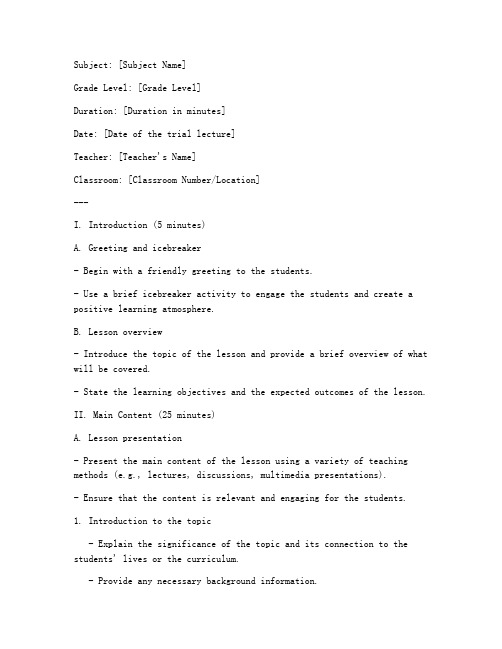
Subject: [Subject Name]Grade Level: [Grade Level]Duration: [Duration in minutes]Date: [Date of the trial lecture]Teacher: [Teacher's Name]Classroom: [Classroom Number/Location]---I. Introduction (5 minutes)A. Greeting and icebreaker- Begin with a friendly greeting to the students.- Use a brief icebreaker activity to engage the students and create a positive learning atmosphere.B. Lesson overview- Introduce the topic of the lesson and provide a brief overview of what will be covered.- State the learning objectives and the expected outcomes of the lesson.II. Main Content (25 minutes)A. Lesson presentation- Present the main content of the lesson using a variety of teaching methods (e.g., lectures, discussions, multimedia presentations).- Ensure that the content is relevant and engaging for the students.1. Introduction to the topic- Explain the significance of the topic and its connection to the students' lives or the curriculum.- Provide any necessary background information.2. Key concepts and information- Present the key concepts and information in a structured andlogical manner.- Use visuals, examples, and real-life applications to enhance understanding.3. Interactive activities- Incorporate interactive activities such as group discussions, problem-solving tasks, or hands-on experiments to reinforce learning.- Encourage active participation and collaboration among students.B. Student engagement- Monitor student participation and engagement throughout the lesson.- Provide opportunities for students to ask questions and seek clarification.- Adjust the pace and depth of the lesson based on student responses and needs.---III. Practice and Application (15 minutes)A. Guided practice- Guide students through a series of practice exercises to apply the new concepts and skills.- Offer step-by-step instructions and provide examples to assist students in their practice.B. Independent practice- Allow students to work independently on exercises to reinforce their understanding.- Circulate around the classroom to provide individual assistance and feedback.---IV. Closure (5 minutes)A. Summary and review- Summarize the key points of the lesson and review any important concepts or information.- Encourage students to reflect on what they have learned and how they can apply it in their lives or future studies.B. Homework assignment- Assign homework to reinforce the lesson's content and provide students with additional practice.- Clearly explain the homework instructions and due date.C. Evaluation and feedback- Provide feedback on the trial lecture, focusing on areas of strength and areas for improvement.- Seek feedback from students regarding their learning experience.---V. Assessment (Optional)A. Formative assessment- Use informal assessment methods such as quizzes, class discussions, or peer reviews to gauge student understanding and progress.- Adjust the lesson plan based on the formative assessment results.B. Summative assessment- Plan for a summative assessment at the end of the unit or lesson to evaluate student learning outcomes.- Consider using quizzes, tests, projects, or presentations as part of the summative assessment.---VI. Conclusion- Thank the students for their participation and engagement.- End the trial lecture with a positive note, encouraging students to continue learning and exploring the subject matter.。
外教英文授课教案模板范文

Subject: [Language Name] (e.g., English)Grade Level: [Grade or Age Group]Course Title: [Course Name] (e.g., Advanced English Communication)Lesson Title: [Specific Lesson Topic]Objective(s):- By the end of this lesson, students will be able to:1. [Skill 1] (e.g., Use past tense correctly in sentences)2. [Skill 2] (e.g., Understand and discuss current events)3. [Cognitive Objective] (e.g., Enhance vocabulary related to [specific theme])Materials:- Textbook or workbook: [Title]- Handouts: [List any additional handouts or resources]- Technology: [Computer, projector, internet access, etc.]- Board/whiteboard and markers- Flashcards- TimerWarm-Up (5 minutes):- Activity: [Description of warm-up activity, e.g., a quick vocabulary game or a brief conversation about the weather]- Purpose: To engage students and review previous lesson material or to set a positive tone for the class.Introduction (5 minutes):- Activity: [Description of introduction activity, e.g., a brief discussion on the lesson topic or a short presentation]- Purpose: To introduce the main topic and objectives of the lesson.Main Activity (15-20 minutes):- Activity 1: [Description of the first activity, e.g., reading comprehension passage, listening exercise, or group discussion]- Directions: [Step-by-step instructions for the activity]- Guided Practice: [Teacher demonstration or guided practice]- Independent Practice: [Students complete the activity on their own]- Activity 2: [Description of the second activity, e.g., role-playing, pair work, or writing exercise]- Directions: [Step-by-step instructions for the activity]- Guided Practice: [Teacher demonstration or guided practice]- Independent Practice: [Students complete the activity on their own]Group Work (10 minutes):- Activity: [Description of group work activity, e.g., group discussion or project]- Directions: [Step-by-step instructions for the group work]- Purpose: To encourage collaboration and reinforce the lesson objectives.Conclusion (5 minutes):- Activity: [Description of conclusion activity, e.g., a review game, summary of the lesson, or reflection on learning]- Purpose: To reinforce learning and provide students with an opportunity to reflect on the lesson.Homework:- Assignment: [Description of homework assignment, e.g., reading a chapter, writing a short essay, or preparing for an upcoming presentation]- Purpose: To extend learning beyond the classroom and reinforce lesson objectives.Assessment:- Formative Assessment: [How you will assess student understanding and participation during the lesson, e.g., observations, quizzes, or peer feedback]- Summative Assessment: [How you will assess student learning at the end of the unit or course, e.g., final exam, project, or presentation]Differentiation:- Strategies for Differentiated Instruction: [How you will accommodate diverse learning needs, e.g., providing additional support forstruggling students, offering extension activities for advanced learners, or using visuals and alternative formats for diverse learners]Reflection:- Post-Lesson Reflection: [Notes on what worked well, what could be improved, and any unexpected challenges or successes]Additional Notes:- [Any additional information or reminders, e.g., cultural considerations, pronunciation tips, or specific vocabulary to focus on]---This template provides a structured outline for creating an English lesson plan. Adapt it to fit the specific needs and goals of your class, and remember to be flexible and responsive to your students' learning styles and progress.。
英国老师授课讲义模板wordpartsbook
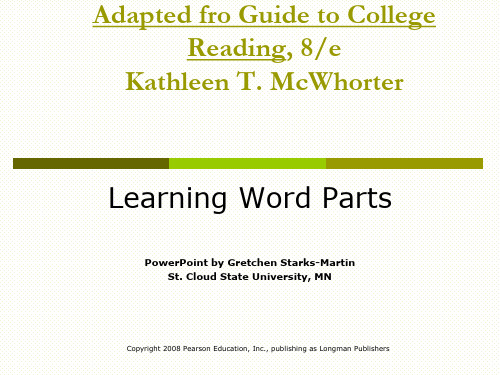
Common Suffixes are on page 53
SUFFIXES
Suffixes are word endings that often change the part of speech of a word: Adding the suffix y to the noun cloud forms the adjective cloudy. Cloudy means “resembling clouds; overcast with clouds; dimmed or dulled as if by clouds.”
Copyright 2008 Pearson Education, Inc., publishing as Longman Publishers
SELF-TEST SUMMARY
When you cannot figure out an unknown word by using context clues, what should you do?
THIS CHAPTER WILL SHOW YOU HOW TO:
1. Figure out the meaning of unfamiliar words
2. Use prefixes, roots, and suffixes
Copyright 2008 Pearson Education, Inc., publishing as Longman Publishers
pand Your Vocabulary
Learn variations in meaning that occur when suffixes are added to words you already know.
英国老师授课讲义模板wordpartsbook
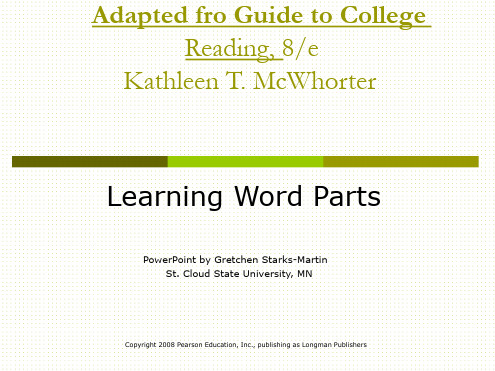
? Endpoint
end + point
? Checklist
check + list
? Outcome
out + come
Copyright 2008 Pearson Education, Inc., publishing as Longman Publishers
FINDING MEANINGS IN COMPOUND WORDS
Common Roots are on page 41.
ROOTS
Roots carry the basic or core meaning of a word.
? Root dic/dict = means “tell or say,” then you know that:
? Dictate = means to speak for someone to write down.
? Examples:
? Root: class ? Root + suffix = class/ify, class/ification,
class/ic ? Root: right ? Root + suffix = right/ly, right/ful, right/ist,
right/eous
? What are prefixes, roots, and suffixes? ? Why is it useful to learn prefixes, roots,
and suffixes?
Copyright 2008 Pearson Education, Inc., publishing as Longman Publishers
英语教师全英文说课稿万能模板
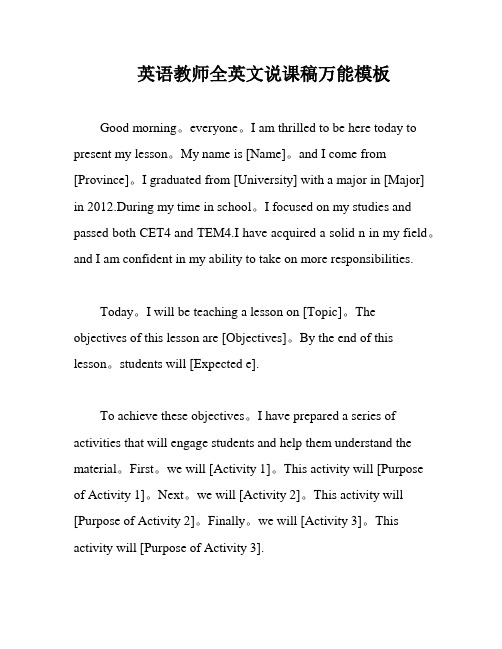
英语教师全英文说课稿万能模板Good morning。
everyone。
I am thrilled to be here today to present my lesson。
My name is [Name]。
and I come from [Province]。
I graduated from [University] with a major in [Major] in 2012.During my time in school。
I focused on my studies and passed both CET4 and TEM4.I have acquired a solid n in my field。
and I am confident in my ability to take on more responsibilities.Today。
I will be teaching a lesson on [Topic]。
The objectives of this lesson are [Objectives]。
By the end of this lesson。
students will [Expected e].To achieve these objectives。
I have prepared a series of activities that will engage students and help them understand the material。
First。
we will [Activity 1]。
This activity will [Purpose of Activity 1]。
Next。
we will [Activity 2]。
This activity will [Purpose of Activity 2]。
Finally。
we will [Activity 3]。
(教育专用)教师说课上课PPT模板 (95)
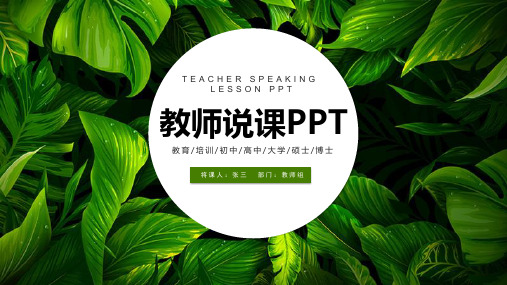
75%
2014-15
详细内容……点击输入本 栏的具体文字,简明扼要 的说明分项内容,此为概
念图解。
100%
2015-16
详细内容……点击输入本 栏的具体文字,简明扼要 的说明分项内容,此为概
念图解。
教学过程
Te a c h i n g P r o c e s s
教学过程
TEACHING PROCESS
教学准备
TEACHING PREPARATION
输入你的标题
详细内容……点击输入本栏的具体文字,简明扼要的说明分项内容,此为概念图解。
2012
2013
2014 2015
25%
2012-13
详细内容……点击输入本 栏的具体文字,简明扼要 的说明分项内容,此为概
念图解。
50%
2013-14
详细内容……点击输入本 栏的具体文字,简明扼要 的说明分项内容,此为概
01
AWESOME SLIDES
02
HIGH QUALITY
03
INFOGRAPHICS
04
CREATIVITY
05
INNOVATION
教学目标
TEACHING GOAL
输入你的标题
详细内容……点击输入本栏的具体文 字详细内容……点击输入本栏的具体 文字,简明扼要的说明分项内容, 此为概念图解。
详细内容……点击输入本栏的 具体文字详细内容……点击输 入本栏的具体文字,简明扼要 的说明分项内容,此为概念图 解。
教学内容
TEACHING CONTENT
输入你的标题
详细内容……点击输入本 栏的具体文字,简明扼要 的说明分项内容,此为概 念图解。
英语讲课优秀课件模板范文
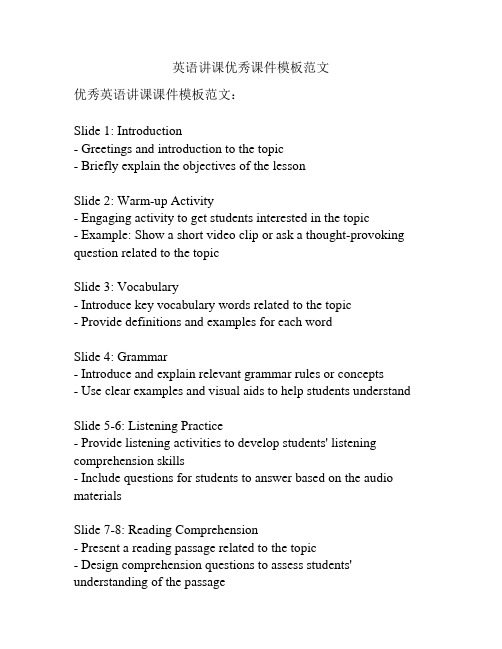
英语讲课优秀课件模板范文优秀英语讲课课件模板范文:Slide 1: Introduction- Greetings and introduction to the topic- Briefly explain the objectives of the lessonSlide 2: Warm-up Activity- Engaging activity to get students interested in the topic- Example: Show a short video clip or ask a thought-provoking question related to the topicSlide 3: Vocabulary- Introduce key vocabulary words related to the topic- Provide definitions and examples for each wordSlide 4: Grammar- Introduce and explain relevant grammar rules or concepts- Use clear examples and visual aids to help students understand Slide 5-6: Listening Practice- Provide listening activities to develop students' listening comprehension skills- Include questions for students to answer based on the audio materialsSlide 7-8: Reading Comprehension- Present a reading passage related to the topic- Design comprehension questions to assess students' understanding of the passageSlide 9-10: Speaking Practice- Include speaking activities that encourage students to use the target language- Provide prompts or role-plays for students to practice speaking in a meaningful contextSlide 11-12: Writing Task- Present a writing task related to the topic- Provide guidelines and a clear rubric for students to follow while completing the taskSlide 13: Group Discussion- Assign students to small groups and provide discussion topics related to the lesson- Encourage students to share their opinions and ideas with their peersSlide 14: Review and Recap- Summarize the main points covered in the lesson- Review key vocabulary words and grammar conceptsSlide 15: Conclusion- Conclusion and summary of the lesson- Encourage students to ask questions or seek clarification on any points they may still haveSlide 16: Additional Resources- Provide additional resources for students to explore if they are interested in further learning about the topic- Example: Suggested books, websites, or videos related to the topicSlide 17: Thank You and Closure- Thank the students for their attention and participation- Provide any additional information or reminders related to future lessons or assignmentsNote: The above template provides a general framework for an excellent English teaching lesson. The text accompanying each slide should be concise and clear, providing enough information to guide the teacher's presentation and engage the students in learning.Slide 3:Vocabulary- Key vocabulary words related to the topic1. Communicate - to exchange information or ideas with othersExample: The ability to communicate effectively is important in any job.2. Fluency - the ability to speak or write a language easily and accuratelyExample: She has achieved fluency in French after years of study.3. Pronunciation - the way in which a word or language is pronouncedExample: It's important to practice correct pronunciation when learning a new language.4. Vocabulary - the body of words used in a particular language or field of studyExample: He has an extensive vocabulary and can easily express his thoughts.Slide 4:Grammar- Relevant grammar rules or concepts1. Verb tenses - the different forms of verbs that indicate when an action or condition occursExample: We use the present perfect tense to talk about past actions that are still relevant to the present.2. Sentence structure - the organization and arrangement of words in a sentenceExample: In English, the basic sentence structure is subject-verb-object.3. Articles - words used to specify a noun as definite or indefinite Example: "The" is used to specify a specific noun, while "a" or "an" is used for any non-specific noun.4. Modal verbs - auxiliary verbs used to express ability, possibility, permission, or obligationExample: "Can" is a modal verb that indicates ability, while "should" indicates obligation.Slide 11-12:Speaking Practice- Speaking activities that encourage students to use the target language1. Role-plays - Assign students different roles and have them act out a conversation using the target language.Example: Have students practice ordering food in a restaurant using the target language.2. Debate - Divide students into teams and have them debate on a topic using the target language.Example: Discuss the pros and cons of social media in today's society.3. Group discussions - Assign students to small groups and provide discussion questions related to the topic.Example: Discuss the advantages and disadvantages of studying abroad.Slide 13:Group Discussion- Assign students to small groups and provide discussion topics related to the lesson1. What are some effective ways to improve communication skills in a foreign language?2. How important is pronunciation in learning a new language?3. Discuss the impact of technology on language learning.Slide 16:Additional Resources- Provide additional resources for further learning about the topic1. Websites: Duolingo, FluentU, BBC Learning English2. Books: "Fluent Forever" by Gabriel Wyner, "The Language Instinct" by Steven Pinker3. Videos: TED Talks on language learning or communication skillsSlide 17:Thank You and Closure- Thank the students for their attention and participation- Provide any additional information or reminders related to future lessons or assignments- Encourage students to continue practicing and expanding their English skills in everyday life.。
英语教师讲座课件模板范文
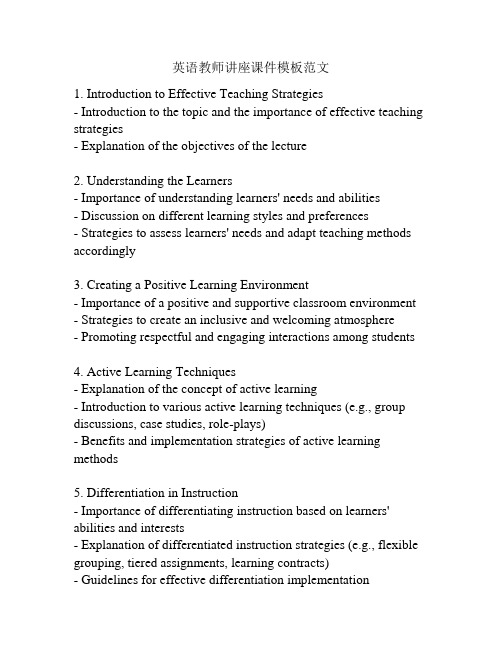
英语教师讲座课件模板范文1. Introduction to Effective Teaching Strategies- Introduction to the topic and the importance of effective teaching strategies- Explanation of the objectives of the lecture2. Understanding the Learners- Importance of understanding learners' needs and abilities- Discussion on different learning styles and preferences- Strategies to assess learners' needs and adapt teaching methods accordingly3. Creating a Positive Learning Environment- Importance of a positive and supportive classroom environment - Strategies to create an inclusive and welcoming atmosphere- Promoting respectful and engaging interactions among students 4. Active Learning Techniques- Explanation of the concept of active learning- Introduction to various active learning techniques (e.g., group discussions, case studies, role-plays)- Benefits and implementation strategies of active learning methods5. Differentiation in Instruction- Importance of differentiating instruction based on learners' abilities and interests- Explanation of differentiated instruction strategies (e.g., flexible grouping, tiered assignments, learning contracts)- Guidelines for effective differentiation implementation6. Incorporating Technology in Teaching- Introduction to the role of technology in modern classrooms- Showcase of various technology tools and resources for effective teaching- Tips for integrating technology seamlessly into daily instruction 7. Assessment and Feedback- Importance of continuous assessment and timely feedback- Explanation of different assessment techniques (e.g., formative, summative, authentic)- Strategies for providing constructive feedback and promoting student growth8. Collaboration and Professional Development- Importance of collaboration among teachers and continuous professional development- Discussion on various ways to collaborate with colleagues and share best practices- Tips for effective professional development planning and implementation9. Conclusion- Summary of the main points covered in the lecture- Encouragement for teachers to implement the discussed strategies in their own classrooms- Final thoughts and closing remarks10. Utilizing Different Instructional Materials and Resources- Importance of using a variety of instructional materials and resources to cater to different learning styles and preferences- Introduction to different types of instructional materials (e.g., textbooks, multimedia resources, hands-on materials)- Strategies for effectively incorporating these materials into lesson plans11. Effective Classroom Management- Importance of establishing and maintaining a well-managed classroom- Discussion on various classroom management techniques (e.g., setting clear expectations, establishing consistent routines, using positive reinforcement)- Strategies for addressing disruptive behavior and fostering a positive learning environment12. Culturally Responsive Teaching- Explanation of the importance of cultural responsiveness in the classroom- Introduction to strategies for incorporating diverse cultures and perspectives into teaching practices- Tips for creating an inclusive learning environment that values and respects students' cultural backgrounds13. Differentiating Assessment and Assignments- Importance of tailoring assessments and assignments to meet the diverse needs and abilities of students- Explanation of strategies for differentiating assessments (e.g., offering choices, providing scaffolding, using alternative formats) - Ways to provide support and accommodations for students with special needs14. Engaging Parents and Guardians- Discussion on the importance of involving parents and guardians in a child's education- Strategies for effective communication and collaboration with parents- Tips for involving parents in the learning process and promoting parent-teacher partnerships15. Reflective Teaching and Continuous Improvement- Importance of reflective teaching and continuous professional growth- Discussion on the benefits of reflective practices (e.g., self-reflection, peer observation, seeking feedback)- Strategies for implementing reflective practices and using them to improve teaching strategies and student outcomes16. Addressing Individual Learner Needs- Importance of addressing the individual needs of students- Introduction to strategies for differentiation and personalized learning- Ways to provide targeted support and enrichment for students based on their abilities and interests17. Establishing Learning Goals and Objectives- Explanation of the importance of setting clear learning goals and objectives- Strategies for writing effective learning goals and aligning them with curriculum standards- Tips for involving students in goal setting and monitoring their own progress18. Building Relationships and Rapport with Students- Importance of building positive relationships and rapport with students- Strategies for fostering a supportive and trusting teacher-student relationship- Tips for creating a safe and inclusive classroom where students feel valued and respected19. Reflecting on the Impact of Teaching Strategies- Discussion on the importance of reflecting on the effectiveness of teaching strategies- Strategies for collecting and analyzing data to evaluate the impact of teaching methods- Ways to make informed decisions and modifications to improve teaching and learning20. Conclusion and Call to Action- Summary of the main points covered throughout the lecture- Encouragement for teachers to consistently implement and refine the discussed effective teaching strategies- Final thoughts and motivation for teachers to make a positive impact on their students' learning and development.。
英文老师课件教案范文模板
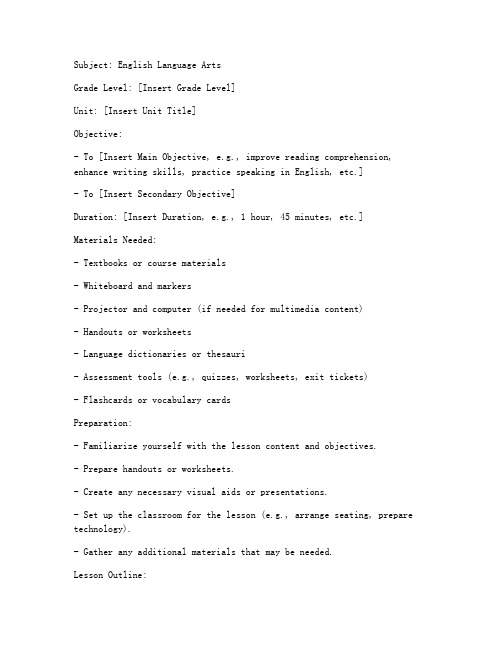
Subject: English Language ArtsGrade Level: [Insert Grade Level]Unit: [Insert Unit Title]Objective:- To [Insert Main Objective, e.g., improve reading comprehension, enhance writing skills, practice speaking in English, etc.]- To [Insert Secondary Objective]Duration: [Insert Duration, e.g., 1 hour, 45 minutes, etc.]Materials Needed:- Textbooks or course materials- Whiteboard and markers- Projector and computer (if needed for multimedia content)- Handouts or worksheets- Language dictionaries or thesauri- Assessment tools (e.g., quizzes, worksheets, exit tickets)- Flashcards or vocabulary cardsPreparation:- Familiarize yourself with the lesson content and objectives.- Prepare handouts or worksheets.- Create any necessary visual aids or presentations.- Set up the classroom for the lesson (e.g., arrange seating, prepare technology).- Gather any additional materials that may be needed.Lesson Outline:I. Introduction (5 minutes)- Greet students and establish a positive learning environment.- Briefly review the previous lesson or introduce the new topic.- State the objectives for the lesson clearly.II. Warm-Up Activity (10 minutes)- Engage students with a quick activity to review previous knowledge or introduce new vocabulary.- Examples:- Vocabulary matching game- Quick quiz on key terms- Brainstorming session related to the lesson topicIII. Main Content (20-30 minutes)- Present new material through various teaching methods (e.g., lectures, discussions, group work).- Examples:- Explain grammar rules or sentence structure- Discuss a literary work or current event- Demonstrate a new vocabulary listIV. Interactive Activities (15-20 minutes)- Facilitate student interaction and practice through activities such as:- Pair work or group discussions- Role-playing scenarios- Debates or presentations- Writing exercisesV. Review and Practice (10-15 minutes)- Review the main points of the lesson.- Provide practice exercises to reinforce learning.- Examples:- Short writing prompts- Vocabulary exercises- Grammar practice exercisesVI. Conclusion (5 minutes)- Summarize the lesson objectives and key points.- Encourage students to reflect on what they have learned.- Assign homework or outline the next lesson's objectives.Assessment:- Formative assessment:- Observation of student participation and engagement- Completion of in-class activities and exercises- Peer or self-assessment activities- Summative assessment:- Quizzes or tests- Written assignments- Oral presentationsHomework Assignment:- Assign relevant homework that complements the lesson and reinforces learning.- Examples:- Reading assignment- Writing assignment- Vocabulary practice- Research projectReflection:- After the lesson, reflect on the effectiveness of the teaching methods used.- Consider what worked well and what could be improved for future lessons.- Update the lesson plan template with any changes or additions for future reference.Note:- Adjust the lesson plan as needed based on student needs, learning styles, and time constraints.- Be flexible and responsive to student feedback and engagement levels.---This template provides a structured outline for an English teacher's lesson plan. It can be customized according to specific curriculum requirements, student needs, and the teacher's preferred teaching style.。
英语教师讲课模板ppt
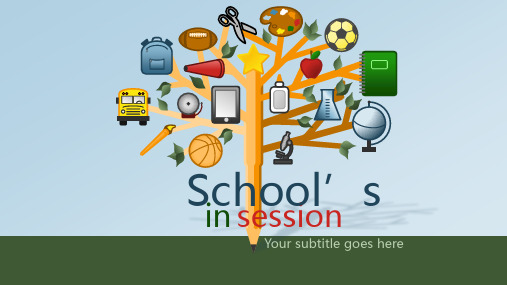
The animation automatically begins.
Your text goes here Writing Your text goes here. Your text goes here. Geography Your text goes here. Your text goes here. History Your text goes here. Your text goes here. Math Your text goes here. Your text goes here. Science Your text goes here. Your text goes here.
Your text goes here. Your text goes here. Your text goes here.
Additional information
Your text goes here. Your text goes here. Your text goes here. Your text goes here. Your text goes here.
Arts point four
Your text goes here. Your text goes here. Your text goes here. Your text goes here. Your text goes here.
Pencil points static Your text goes here. Your text goes
10:00 to 11:00 a.m. Your text goes here
Your text goes here. Your text goes here. Your text goes here.
实用!英语教师英文授课模板!
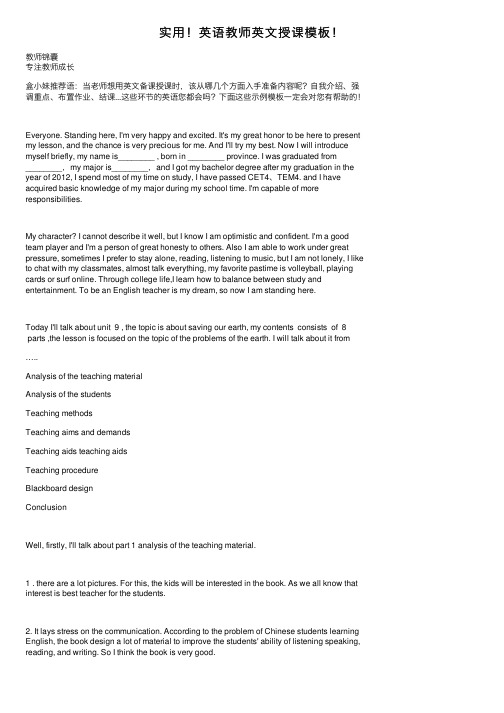
实⽤!英语教师英⽂授课模板!教师锦囊专注教师成长盒⼩妹推荐语:当⽼师想⽤英⽂备课授课时,该从哪⼏个⽅⾯⼊⼿准备内容呢?⾃我介绍、强调重点、布置作业、结课...这些环节的英语您都会吗?下⾯这些⽰例模板⼀定会对您有帮助的!Everyone. Standing here, I'm very happy and excited. It's my great honor to be here to present my lesson, and the chance is very precious for me. And I'll try my best. Now I will introduce myself briefly, my name is________ , born in ________ province. I was graduated from________,my major is________,and I got my bachelor degree after my graduation in the year of 2012, I spend most of my time on study, I have passed CET4、TEM4. and I have acquired basic knowledge of my major during my school time. I'm capable of more responsibilities.My character? I cannot describe it well, but I know I am optimistic and confident. I'm a good team player and I'm a person of great honesty to others. Also I am able to work under great pressure, sometimes I prefer to stay alone, reading, listening to music, but I am not lonely, I like to chat with my classmates, almost talk everything, my favorite pastime is volleyball, playing cards or surf online. Through college life,I learn how to balance between study and entertainment. To be an English teacher is my dream, so now I am standing here.Today I'll talk about unit 9 , the topic is about saving our earth, my contents consists of 8parts ,the lesson is focused on the topic of the problems of the earth. I will talk about it from …..Analysis of the teaching materialAnalysis of the studentsTeaching methodsTeaching aims and demandsTeaching aids teaching aidsTeaching procedureBlackboard designConclusionWell, firstly, I'll talk about part 1 analysis of the teaching material.1 . there are a lot pictures. For this, the kids will be interested in the book. As we all know that interest is best teacher for the students.2. It lays stress on the communication. According to the problem of Chinese students learning English, the book design a lot of material to improve the students' ability of listening speaking, reading, and writing. So I think the book is very good.Then I'll talk about next part analysis of the students. It is known to us that the kids are very active and like playing games very much, so during my class, I'll design some interesting games to activate them to participate and learn something. They will also be interested in the class.Next I'll talk about teaching methods. My teaching methods are task-based approach and situational approach. Using different methods can make the class active.Let's move on to another part, teaching aims and demands. There are knowledge aims and ability aim. Knowledge aims are to enable the students to master the words and phrases… And the sentences…Knowledge Aims1. Talk about nature, ecology and the environment.2. Make the Ss know the Earth Summit and the importance of the environment.3. Further develop students' reading ability as well as listening and speaking abilities.4. Make the Ss learn some useful words and expressions.5. Arouse the Ss to take better care of the earth.(1) To enable the Ss to understand and speak this topic:Saving the earth make sure that Ss can use useful expressions in real situations.We must make sure that…I am all for…Sure/ certainly/AbsoluteIt's clear that…If nothing is done…, then…It would be better if we…I believe that we must…I can't imagine that….Is there a better way to…(2) To help Ss to learn Make Ss learn some useful words and expressions as well as inversion. Ability aimsAbility aims are to improve students' listening and speaking ability by reading and joining activities.(1) To develop Ss' abilities of listening and speaking(2) To train the Ss' ability of working in groups(3) To foster Ss' abilities of communicationEmotional Aims(1)To build Ss' senses of good co-operation and care of our earth.(2) To lead Ss to show their loveliness to the poor.Now I'm going to talk about next part is the teaching aids .In this class, I'll use pictures, PPT and tape recorder. These can arouse the students' interest in English.Now I'll talk about most important part teaching procedure.New English proverb said that the students are real master. In this lesson they are English learners and real master .So teacher should act as a guider, an organizer and a director who play a role when necessary in teaching procedure. In my English Plan, It consists of 5 steps. Warming up, lead-in, contents key points and difficult points and homework.Step1 is warming upHere I'll use PPT to play an English song Bingo for the students and I'll ask them try to follow it to sing together. By this, the students can be interested in it and pay their attention to our class easily and improve their ability of speaking.Free talk between T and Ss about problems what we are facing in the classroom.Step2 is lead-in(导⼊根据所授内容设计,可通过展⽰与本课有关的话题或者图⽚等等引出本课话题)1. At the beginning, Begin the class by showing some pictures of serious environmentalproblems. Now the earth is being seriously polluted.2. Ask the Ss some questions.What’s the biggest problem facing the earth? Why do you think so?What causes the problem?What are the' big three”? Do you know of any other major problems facing the earth?What can we do solve the problem?Step 3 is contents(本部分为主要授课内容及组织的课堂活动。
- 1、下载文档前请自行甄别文档内容的完整性,平台不提供额外的编辑、内容补充、找答案等附加服务。
- 2、"仅部分预览"的文档,不可在线预览部分如存在完整性等问题,可反馈申请退款(可完整预览的文档不适用该条件!)。
- 3、如文档侵犯您的权益,请联系客服反馈,我们会尽快为您处理(人工客服工作时间:9:00-18:30)。
•Programming Language: PHP,
外国学校教师授课讲义 模板open-source-
librar
PPT文档演模板
2020/11/14
外国学校教师授课讲义模板 opensourcelibrar
Presentation will cover
• Need for Free/Open Source software. • What is Free/Open Source software? • Features of free software • Features of open source software • Integrated Library Management System (ILMS) • Free/Open Source ILMS • Koha, PhpMylibrary and OpenBiblio • Findings • Suggestions
• To find a less costly and efficient library software.
PPT文档演模板
外国学校教师授课讲义模板 opensourcelibrar
Popular commercial ILMS
Name Libsuite
Appoximate Price
Rs. 4,50,000
opensourcelibrar
PPT文档演模板
•OpenBiblio features
•Barcode input •web-based OPAC, •circulation and management interfaces, •MARC support, •Online Reservations& Renewals, •Barcode Generator •Report Generator •Interface customization
•web-based OPAC, •circulation and management interfaces, •MARC support, CDS/ISIS conversion •Online Reservations& Renewals, •Report Generator •Interface customization
•Operating System: Linux, Windows
•Programming Language: PHP
•Functional Modules: Acquisition, Cataloguing, Circulation •Home Page: http://obi外b国lio学.校s教o师u授rc课e讲f义o模rg板/
•Programming Language: Perl
•Functional Modules: Acquisition
•Cataloguing, Circulation, Serial Control
•Home Page:
外国学校教师授课讲义模板 opensourcelibrar
• E-mail Overdue Notifications.
•Virtual Shelves
•Barcode Generator
外国学校教师授课讲义模板 opensourcelibrar
PPT文档演模板
•Developer: Dave Stevens
•License: GNU General Public License (GPL)
LibSys
Rs. 4,50,000
SOUL
Rs. 50,000
Alice for WINDOWS
PPT文档演模板
Rs. 3,50,000
外国学校教师授课讲义模板 opensourcelibrar
Free/Open Source ILMS
• Avanthi Circulation System
• Emilda • FireFly • Koha • PhpMylibrary • OpenBiblio
PPT文档演模板
外国学校教师授课讲义模板 opensourcelibrar
Features of Free Software
• GNU public license (GPL). • Anybody can do anything with public domain
works. • 73 % of free softwares registered under
• WEBLIS • OpenILS • PhpMyBibli • GNUTECA • PMB • Learning Access ILS • FireFly
PPT文档演模板
外国学校教师授课讲义模板 opensourcelibrar
PPT文档演模板
•Koha •OpenBiblio •PhpMyLibrary
“an automated library system that is capable of managing the operations of more than one basic library functions” -UNESCO
PPT文档演模板
外国学校教师授课讲义模板 opensourcelibrar
外国学校教师授课讲义模板 opensourcelibrar
Methodology of the study
• Selection of free/open source ILMS • Installation and running the softwares entering
sample data • Data collection using a checklist • Scoring of software performance • Computation of the performance of free/open
of their programs
PPT文档演模板
外国学校教师授课讲义模板 opensourcelibrar
What is Free/Open Source Software?
Free/Open Source software is , software that users have the ability to run, distribute, study, and modify the program for any purpose.
GPL Licencse.
PPT文档演模板
外国学校教师授课讲义模板 opensourcelibrar
Features of Open Source software
• Historically evolved from free software. • Open source grants 4 freedom (run, study, distribute
source ILMS
PPT文档演模板
外国学校教师授课讲义模板 opensourcelibrar
Data collection list
•1. ACQUISITION •Selection of Items •Duplicate checking •Selection of Vendors •Ordering •Claiming •Receipting •Fund control •Reports & statistics •2. CATALOGUING •Recording Creation •Duplicate checking •Record editing •Authority control •Cataloguing copies •Key word/ thesaurus generation •Import & export of data
PL/SQL,
Python
•Functional Modules:
Acquisition
•
Cataloguing
•
Circulation
•Home Page:
外国学校教师授课讲义模板 opensourcelibrar
PPT文档演模板
•PhpMyLibrary features
PPT文档演模板
外国学校教师授课讲义模板 opensourcelibrar
Need for Free/Open Source software
• Cost of commercial software's is very high • Commercial developers do not reveal the source code
•5 SERIAL CONTROL •Fund control •Ordering •Receipting •Claiming •Binding •6.Management information •Tools for the analysis of statistical information •7.System maintenance •User assistance (Manual/ literature) •Security of records and files •Up- gradation •Customization
PPT文档演模板
外国学校教师授课讲义模板 opensourcelibrar
History of Free/Open Source Software
• 1984 Richard Stallman formed Free Software Foundation (FSF).
